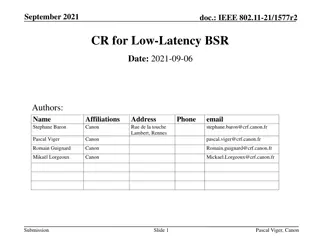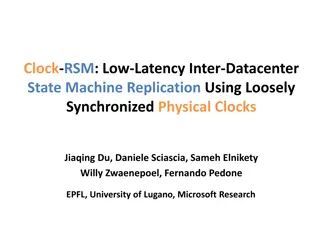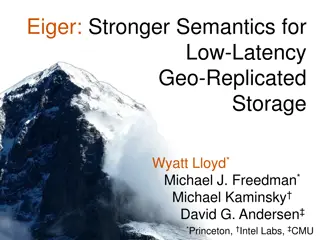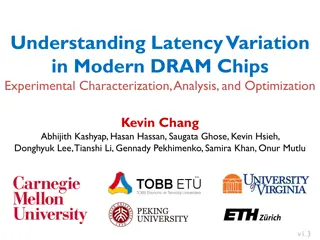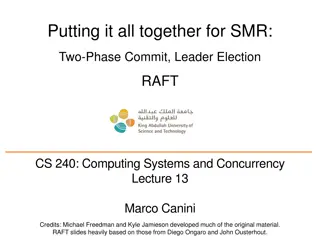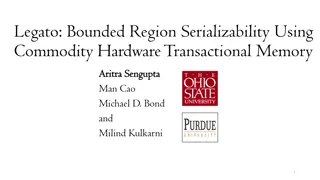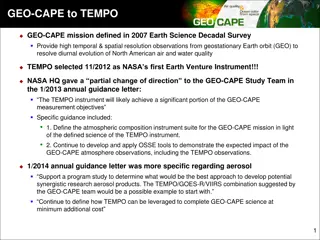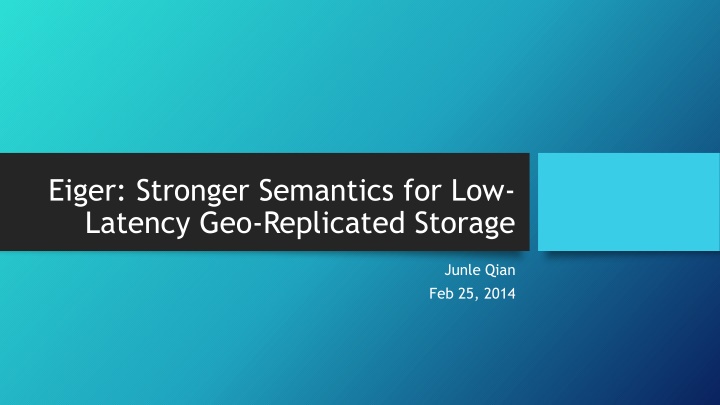
Stronger Semantics for Low-Latency Geo-Replicated Storage
Explore the concepts of strong consistency, low latency, and geo-replicated data centers in the context of massive data storage and web services. Discover how Eiger provides effective solutions for ensuring faster user experiences and mitigating latency issues in distributed storage systems.
Download Presentation

Please find below an Image/Link to download the presentation.
The content on the website is provided AS IS for your information and personal use only. It may not be sold, licensed, or shared on other websites without obtaining consent from the author. If you encounter any issues during the download, it is possible that the publisher has removed the file from their server.
You are allowed to download the files provided on this website for personal or commercial use, subject to the condition that they are used lawfully. All files are the property of their respective owners.
The content on the website is provided AS IS for your information and personal use only. It may not be sold, licensed, or shared on other websites without obtaining consent from the author.
E N D
Presentation Transcript
Eiger: Stronger Semantics for Low- Latency Geo-Replicated Storage Junle Qian Feb 25, 2014
Geo-replicated Data Centers Is the backend of giant websites and web services
Massive Data Storage across Multiple Servers Shard data across multiple servers in a data center E.g., fragmented by alphabetical order of last names A-D Ellen E-H Leon I-K I-K L-N O-T U-Z
Geo-replicated Data Storage Effective mitigation to latency: handle request in nearest data center An increase to availability: higher tolerance A-D Seattle New York E-H San Francisco I-K I-K L-N O-T U-Z
Web Services to Geo-replicated Data Storage Front Tier Servers clients to the data storage system
Eiger: Stronger Semantics for Low- Latency Geo-Replicated Storage
Two Conflicting Goals Theoretically conflict between strong consistency and low latency: [Lipton, Sandberg, 1988] PRAM: A Scalable Shared Memory [Attiya, Welch, 1994] Sequential consistency versus linearizability Strong Consistency: Expected and correct responses to user No anomaly for front tier servers Simpler programming life Low Latency Fast user experience Less seconds wasted other than computation Less money wasted
Problems caused by inconsistency Unfriend Bob (slow) Alice is in friend list, display Bob is Post status(fast): Bob is such a nerdy guy.
Strong Consistency and Eventual Consistency Eventual Consistency Replica convergence More anomalies Low Latency E.g., Dynamo, COPS, Eiger Strong Consistency Satisfies linearizability, serializability, and sequential consistency E.g., Megastore, Walter, Gemini
Comparison with COPS COPS Eiger Data model Key-value(basic) Column-family (richer) Read-only transactions Causal data stores only All types of data stores Write-only transactions N/A Proposed algorithm Performance Good Better Failure Performance degradation resilient
Contributions of Eiger Low Latency (compared to strong consistent systems) Causal Consistency (compared to eventual consistent systems) Rich data model (compare to basic data model systems) Limited forms of transactions Read-only transaction Write-only transaction
Rich Data Model Column Family Column-family data model Column Family Super Column Column Column Used in Google s BigTable Logical Key
Column-family Data Model Compound key and value pair Alice:Associations:Friends:Bob -> 3/2/11 Scale to one access per location Good data abstraction Causal for: Update/read many columns Range access columns with deletes Counter columns
Read-only Transaction Consistent view of multiple Keys across many servers in the local data center Leftmost: earliest valid time Right most: latest valid time Vertical line: effective time EVT LVT Max of LVT < Min of EVT => Not a consistent view EffT
Read-only Transaction Condition to fire the second round Maximum of earliest valid time(EVT) > the minimum of latest valid time Worst case: two rounds One fold of low latency
Write-only Transaction Allows a client to atomically write many columns across many servers 2.5 RTT locally, no locks (for low latency) A variant of traditional 2PC (2 phase commit)
Write-only Transaction dependencies of operations centralism in a distributed system No abort
Check nearest dependencies Eiger Dependency check based on operations One check per value Dep_check function does block Loosely blocks behind the local data center COPS Dependency check based on values Multiple checks per value
Dependency examples Eiger COPS Nearest: w3 only one check Nearest dependency check: v6 check? y1 check?
Failure Tolerance Both transient and permanent datacenter failures will cause meta-clients to reconnect to different datacenters. Reconnection will avoid previously disconnected data centers Failure resilience Assuming transient datacenter failure will be rare Long transient datacenter failure will be rare Permanent ones will be even rare
Overhead Causal Consistency overhead Dependency metadata carried by write operations Read-only Transaction overheads Double latency if second round is always needed Version storage Write-only Transaction overheads Write column twice (2PC)
Throughput More keys per server, more throughput Due to overhead, throughput is less than a standard-Cassandra Cassandra Eiger
Latency Micro-benchmark Setup: VICCI test bed, Linux Vserver 2x6 core Intel Xeon X5650 CPUs, 48GB RAM, and 2x1GigE network ports Median of operations on single 1Byte columns Greater latency
Dynamic Workloads Generated by dynamic workload generator Less performance from different dimensions Normalized Cassandra to 1.0 ~20% degradation from different dimensions Cassandra Eiger
Facebook workload overhead Columns/sec 505000 Setup: Synthetic workload On TAO system[53] 500000 495000 490000 485000 Max overhead: 6.6% 480000 475000 470000 465000 460000 455000 450000 Cassandra Eiger Columns/sec
Scalability Almost perfectly scale out Fine scalability
Summary Low Latency in sense of: geographical distance quick local response, no locks in one datacenter tracking dependencies on operations rather than values Worst case 2-round read-only transaction algorithm Stronger consistency in sense of: Causal consistency that avoids erroneous front-end behavior Stronger than eventual consistency in previous works Richer data model in sense of: Column-family data model A more practical abstraction Great Scalability


